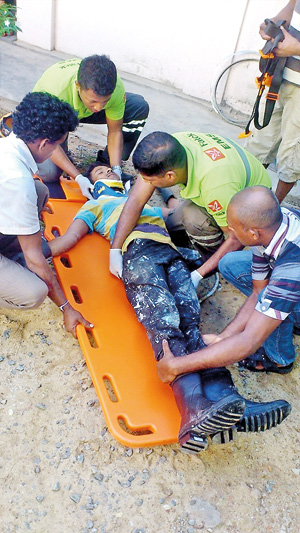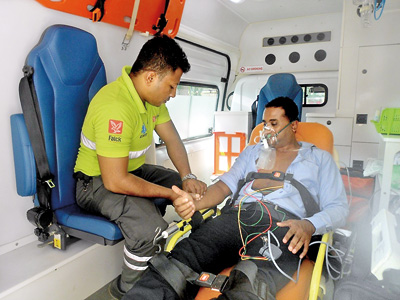The first things about First Aid

Pix by IndikaHandunwala
What happens in the ‘Golden Hour’ following an emergency is quite literally a matter of life and death. Look at it in that perspective and you’re less likely to think of an ambulance simply as a quick mode of transport to the hospital. In fact, a really good Emergency Medical Service (EMS) won’t waste a minute. As far as they’re concerned, they’re on the clock from the moment their staff first answer your call. This month we speak with Jens Poul Madsen, CEO of Falck Sri Lanka about how an EMS can save time, resources and most importantly, lives when deployed correctly.
An EMS is a system that provides emergency medical care before a patient arrives at the hospital. The name itself is an indication of how the role of EMS has evolved over the years. Jens has pictures of the earliest iterations of this service – when men cracked the whip over horses as the animals pulled their ‘ambulance’ carriage through the streets – but modern emergency services are a great deal more complex.
At its centre the ‘Star of Life’ – a symbol for EMS services all over the world – features a stick with a serpent wrapped around it. It is meant to represent the rod of Asclepius, a deity associated with healing and medicine. However, the six points of the star swerve away from mythology to symbolise the six very practical steps that help rescuers coordinate their work across the emergency response chain: Detection, Response, Reporting, On the Scene Care, Care in Transit and Transfer to Definitive Care.
We begin with the first point and the realisation that your ‘rescuers’ may not be who you expect – or even be particularly well equipped to cope. It’s the ordinary people on the scene who first observe and then report a medical crisis. It’s why Jens believes First Aid training is increasingly indispensable for all and also why he applauds recent measures taken by the Sri Lankan government to have all drivers of public vehicles undergo basic training.
The next point on the star represents the emergency call itself. For the call centre operative who answers, the first challenge is often to just calm the caller down. This is something of an art form, says Jens, explaining that people calling on behalf of loved ones, especially children, can be in a state of absolute panic.The operative must start extracting details from the caller as soon as possible, in order to gauge the seriousness of the situation. In some cases a doctor may not be required at all, in others an ambulance may have to be dispatched urgently and sent on its way even as the caller is kept on the line. The call centre operative will have to be kept in the loop and may be required again later in the process to alert the hospital authorities that a patient in serious distress is about to arrive at Emergency.
All the while the minutes are slipping away. Jens says an ideal dispatch system will employ GPS to keep track of where the ambulances are as well as pinpoint the location they need to get to – a process that is only likely to get more challenging as our cities become ever more congested. As the medical team arrives on the scene they can begin to deliver first aid and cope as best as they can with the equipment they have on board.In a best case scenario a patient may be treated on the spot, with no requirement for hospitalisation. However, in cases where CPR must be performed, the timing and training can both prove critical.
 Having done their best to diagnose and treat a patient, the medics may now have to rush the patient to a hospital. As they weave through traffic, the priority now is on point 5, ‘Care in Transit.’ As you can imagine, it’s essential the vehicle be well equipped and the personnel operating it trained in the science of saving lives. (The devil is in the details – such as in the seat belts for the stretcher that bears a patient.) In many countries with a network of public hospitals, the medics are the ones who decide which hospital to take a patient to, but in Sri Lanka the decision of where to go is made by those responsible for the patient, says Jens. However, the team is still held in charge until they’ve completed point 6 – handing over their patient to a hospital for specialised care.
Having done their best to diagnose and treat a patient, the medics may now have to rush the patient to a hospital. As they weave through traffic, the priority now is on point 5, ‘Care in Transit.’ As you can imagine, it’s essential the vehicle be well equipped and the personnel operating it trained in the science of saving lives. (The devil is in the details – such as in the seat belts for the stretcher that bears a patient.) In many countries with a network of public hospitals, the medics are the ones who decide which hospital to take a patient to, but in Sri Lanka the decision of where to go is made by those responsible for the patient, says Jens. However, the team is still held in charge until they’ve completed point 6 – handing over their patient to a hospital for specialised care.
While their responsibility may stop at the door, the transfer can be a critical step in the process. The EMS staff must be able to brief the hospital confidently and accurately, covering all the critical points in a few rushed moments. At times like this, a patient having registered previously with a specific EMS service will have the advantage of their medical history, including drug allergies, being brought to the attention of the doctors who will take over their case.
Though we’ve covered the points, Jens draws attention to the time before and after an EMS team responds to a crisis. It’s a lot of waiting for the staff and a good EMS system takes that into consideration. EMS staff need to undergo retraining at regular intervals and so they need to stay up to date. There are also the things that may not occur to us right away, for instance the teams need to be tremendously fit to be able to perform CPR or manage a patient in distress. For teams, it’s also essential that their equipment and vehicle is functioning perfectly.
Outside the EMS system there is a need to set up “prevention pillars,” notes Jens, advocating for the right equipment, more widespread First Aid training both at home and at work. Offices should train employees to respond appropriately in a crisis.
You can call 1990 any time for free advice on how to cope with a medical emergency.


